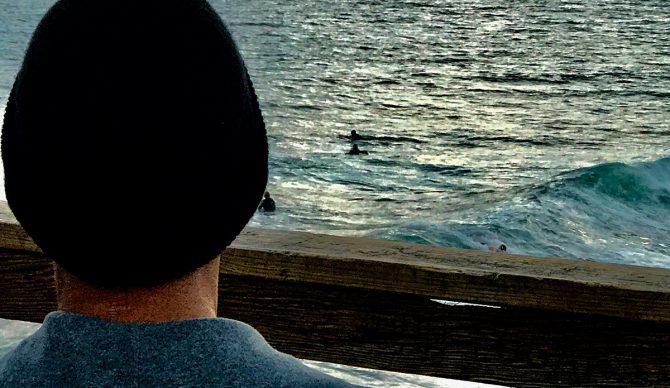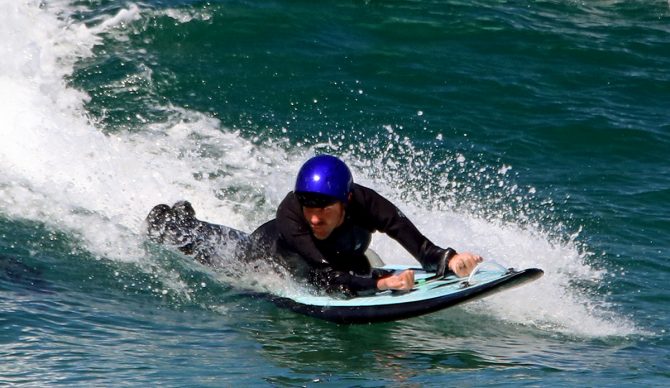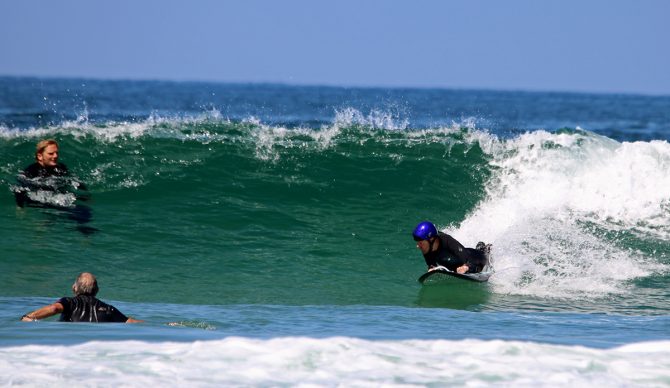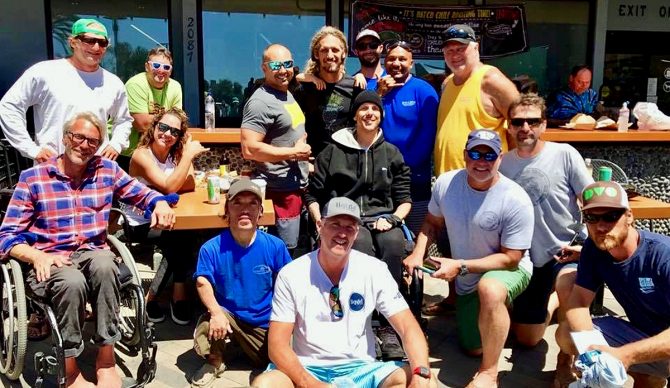
Jay’s last sunset.
Earlier this week, Jay Leisener passed away. He was an incredibly inspiring adaptive surfer who lived the last several decades in a wheelchair. He recently visited San Diego on a bucket list surf trip, choosing quality of life over length of life. He carried out his dream surf trip with his support team and wrote an incredible memoir, “Returning Home for the First Time,” reflecting on the experience of his trip and the adaptive surfing community as a whole.
Here’s what Jay wrote:

If you are lucky, during one of your travels you will find a home that you never knew existed. I had the good fortune to experience this recently. In August, a group of friends and I traveled to San Diego for a week-long surf trip. It was the first time surfing in California for myself and most of the group, and we were met with fun, chest to head high waves for most of the week. And like most trips, it was the stuff we couldn’t plan for that made it all special.
I started adaptive surfing around 13 years ago. I was recovering from surgery myself when I saw Jesse Billauer surf in Step into Liquid. It was a rough time in my life. I had just given up my career as a professor and was halfway through six surgeries over two years to piece myself back together. After losing so much, the prospect of reclaiming a lost passion was exhilarating.
It had been 18 years since I was last in the ocean when I drove myself to the very next Life Rolls On event. Just floating in the salt water and feeling the rhythmic motion of the waves rolling in was instantly familiar and flooded my brain with endorphins. When they pushed me into my first post-injury wave, it was a done deal. I was hooked. I was stoked and I knew that surfing would be part of the rest of my life.
I learned a lot that day. First, I was going to continue surfing. I was reclaiming that part of me no matter what. Second, surfing regularly would take a ton of work. There were few resources for adaptive surfing back then, especially on the East Coast. I am a C4-5 complete quadriplegic and am unable to hold my chest up or even stay on an unmodified surfboard. If I wipe out face down, I can’t roll my body over, which means I need people spaced throughout the line up to grab me when needed. I was tried to recruit everyone I met to assist me in the water. It was difficult at first. It was hard for people to understand how someone with my level of paralysis would be able to surf without it being a death wish. So those first two years I only got in the water once or twice a year. But every time we did go out we learned something, refined my equipment, and gained support for what we were doing. We called ourselves Team Surfgimp as a nod to the fact that we were challenging our own and others’ perceptions of being disabled. The former strangers who agreed to help me in the water became family. My life is in the team’s hands every time we go out and that level of trust bonds us closely. We travel together on weeklong surf trips as often as we can afford. We go to the Outer Banks annually and have visited Puerto Rico, Hawaii and now California. It has been amazing to share these adventures with my best friends. Looking back, I am astounded by how much seeing that clip of Jesse changed and enhanced my life.
At the same time that my surfing and social life have been taking off, my physical health has been declining. I broke my neck almost 30 years ago and time has taken its toll. I’ve always pushed myself too far for my own good. It was the only way that I could survive mentally and feel like I was living a productive life. All of the infections and surgeries had caught up with me and I eventually found myself going from specialist to specialist, spending months on bedrest during the winters so my body could heal. Last year, I reached a point where my body would no longer allow me to be up for even a few hours without my skin breaking down. The decades of atrophy, scar tissue, and bone and muscle damage had finally caught up with me. I had changed every variable I could control and had to make a decision between my quality and length of life.
I chose quality and launched myself full steam into the surfing season.
We started the spring with a trip to Puerto Rico. Including kids, 54 of us made the trip to surf the warm, clear waters of Aguadilla and Rincon. The waves were great and the people were welcoming. In my mind, that was going to be my last big trip. I had decided that once we got home, I was going to live my life fully for as long I could until my body failed.
And that was when I hatched the plan for one more big surf trip with the team.
All of the first images that I had seen as a child were from California, as well as my first images of adaptive surfing. My wife and I had spent all of our discretionary money on trips to Puerto Rico and the Outer Banks, so we could only afford to get ourselves to California for this trip but not the team. We set what we thought was an outlandish goal of fundraising $15,000 and surpassed it in four days. The entire community had embraced the team and allowed us to chase this dream.
On August 12th, 2017, 24 members of Team Surfgimp made their way to California. Our first call was to surf the north jetty at Oceanside. The takeoff spot was a bit shifty, but we got a sense for the place and the team threw me on my board. Making our way out, I noticed that the waves had more power than the East Coast. When the first wave made its way toward us, Adam, my one-man launch crew, gave me a push and suddenly I was looking down a solid chest-high drop. The wave jacked up, the bottom sucked out and I was thrown over the nose of my board. Welcome to the West Coast.
Over the course of my next couple waves, I started to get the feel for things. It felt incredible. For the first time, I had the speed to carve a line all the way up and back down through the face of a wave. We caught three or four more great rides that day before I got too cold to continue.
Back in my chair on the beach, my wife bundled me up in a towel and a fleece lined sweatshirt. This would become my California uniform. I couldn’t stop smiling. I had surfed better than ever. The extra force of the long period waves opened up opportunities to make turns and to take lines on waves that had never been possible for me before.
We decided to check out Cardiff reef late in the afternoon. As we pulled into the parking lot, I noticed a surfer in a wheelchair pulling a wave ski out of his vehicle. His name was Ethan and he was from Pennsylvania, but living in San Diego to participate in the Project Walk program. Ethan had just gotten a new wave ski and was getting it dialed in before the Duke. I was amazed that he had just shown up alone and was hanging around waiting for anyone to help him get his equipment to the water’s edge. I spend days rallying people together every time I surf. As we talked, I was distracted by the break over Ethan’s shoulder. There were two swells hitting the reef from different angles, so it looked more like a six-second wind swell than a 15-second groundswell. But every once in a while a wave lined up right and peeled along the reef for a hundred yards or so. I could see the potential of the break and was excited to get out in the water.
I hustled the team to get us out surfing. As we set up by the river mouth, a few of the team assisted Ethan with getting his equipment down to the water’s edge. I got set up on my board and paddled out. The reef seemed like it was designed for me and the team to surf. We could sit slightly inside of the SUPs and pick up the sets that snuck south of them. These waves connected through several open-faced sections and then would eventually shoulder off after a blast through a steep inside run over the sandbar. With the two swells, these waves were hard to find. Adam and I lucked into a couple that day and they were amazing
I would drop in on the peak with speed to burn, fade back into the face until it walled up again and drop back down. The second bottom turn gave me the momentum to hold the carve through the bottom and then up through the top and then finally back down to charge through the steep section to kick out as it ran back over deeper water. It felt like someone had designed a playground for me. This was what we had flown across the country for.
The next day, we awoke to gray skies and light, but pervasive rain showers. I’ve heard too much about runoff in California and had too many open wounds to venture out. We made the best of it by playing tourists. The sun came back the following day though and we were greeted by clean lines rolling into Oceanside. The conditions were perfect and I was frothing to get back to Cardiff. We pulled into the parking lot to find Ethan and a few other adaptive surfers hanging out by their vehicles.
The waves were everything I had dreamed of. Light winds and glassy chest to head high waves that peeled perfectly along the reef. This was what we had been training for the past 10 years. The team worked like a well-oiled machine, paddling me out through the waves, launching me into the best sets, and spreading out through the inside to be close when I would wipe out. It was a magical day. I did some of the best surfing of my life. Each wave was better and broke three to four times longer than anything I had ever experienced. My skills were growing exponentially. I had found the perfect wave for myself. Conditions stayed the same for the rest of our trip and I couldn’t get enough of that break, so we came back for more each day. As astounded as I was by the quality of waves, I was most surprised and impacted by the prevalence and warmth of the adaptive surfing community.
Over the rest of the week, we’d see Ethan and Mark daily. We also met and got to hang out with Alana Nichols, Charles Webb, Jeff Munson and Sean Brody. Everyone was unbelievably welcoming. We’d surf together until the winds would pick up midday and then go grab some food and talk story. I knew all of these surfers through following the sport and watching the last two world championships. I was honored to share waves with them and was proud to receive the positive feedback that I got from my surfing.

Cardiff, the author’s dream wave.
It was great that they also were impressed by how well the team worked together. They could see the years of effort that it had taken developing the teamwork that allows me to surf confidently. Anything that I do on a wave is because of them, and I was touched to see them getting the recognition they deserve. Every member of my team is my hero, so this was wonderful for me to see.
On Thursday, while eating out post-session lunch at the local grocery store, we crossed paths with none other than Rob Machado. I mentioned to him the impact of his and Jesse’s spot in Step Into Liquid. It had inspired me to get back into the water and added so much quality back into my life. Thanks to that, these past ten years have been my best – pre or post injury. Through this passion, I have built a family that is bigger and stronger than anything I could have imagined. We have traveled and shared adventures together. I have watched their children grow up. And I’ve seen the team open their perspective of what is possible.
Rob mentioned that Cardiff was the first place they took Jesse surfing after his injury and it was also the spot where they’d filmed their segment in Step Into Liquid. Without knowing it, I had returned to the birthplace of this dream that I was chasing. Everything had come full circle – finding the perfect wave and then realizing it was the same wave that had inspired my entire journey.
I also discovered a home for myself in this vibrant community of adaptive surfers. They had taken the team and I in as one of their own and had showered us with opportunities. We had offers to join them the next week at the Duke and to come back for the inaugural U.S. Open Adaptive Surfing event at Oceanside. They were plotting to get us travel money through the Challenged Athlete Foundation and offered to share rooms with us. But unfortunately, my physical condition prevented me from taking advantage of the generosity. It was difficult to say no, but unbelievably heartwarming to know that this strong and growing community of adaptive surfers exists and are pushing the limits of the sport and taking it mainstream.
There are so many opportunities to become a part of the rise of adaptive surfing in Southern California. In all of my travels, I have never seen anything like it. Flying back home to Delaware, I was still amazed by how the general public and the adaptive community had accommodated each other to give these athletes the freedom to surf whenever they want. Plus, they consistently have a variety of good waves on which to hone their skills. It really is a nirvana for adaptive surfers.
If you have a passion and talent for adaptive surfing then you need to find your way to San Diego. Stop by Bird’s Surf Shed or just hang out at Cardiff Reef and wait for the crew to find you. I left a bit of my heart there and I hope that the memory of me and Team Surfgimp will live on with the new friends we made. Moments like these are rare, so pack up your bags and book a flight. In the words of Warren Miller, “If you don’t do it this year, you’ll just be one year older when you do.”

With the team…and Rob Machado.
Editor’s Note for the adaptive surfing community:
If you don’t have the means, apply for a grant through the Challenged Athletes Foundation.
You can follow Team Surf Gimp on Facebook here.
This article can be found in the Adaptive Surfing Association’s publication, Adaptive Surfing Magazine Vol. 3 and on https://www.adaptivesurfing.com/

